
🌳 A Guide to Sleeping in a Hammock (Tips for a Comfortable Night)
🌳 Sleeping in a Hammock: A Guide to a Restful Night Outdoors 🌳
There is a certain romance to the idea of sleeping in a hammock. Gently swaying in the breeze, suspended under the stars. It is an image of pure outdoor freedom. For many campers, it has replaced the traditional tent. It is a lightweight and comfortable way to sleep in nature.
However, a good night's sleep in a hammock is not as simple as just stringing it up. There is a technique to it. Without the right setup and a few key tricks, you could end up with a sore back and a cold body.
This guide will show you how to do it right. We will cover the benefits, the challenges, and the essential tips. Get ready to have the most comfortable sleep of your camping life. 😴
👍 What Are the Potential Benefits of Sleeping in a Hammock?
Many people report that they sleep better in a hammock than in a bed. The unique experience of being suspended offers several advantages. These benefits are why hammock camping is so popular.
- Deeper Sleep: The gentle, rocking motion of a hammock can be very soothing. Studies have shown it can help people fall asleep faster. It may also promote a deeper, more restorative sleep.
- No Pressure Points: Unlike sleeping on the ground, a hammock conforms to your body. This eliminates uncomfortable pressure points on your hips and shoulders.
- Comfort on Any Terrain: You can set up a hammock over rocky, sloped, or uneven ground. This is somewhere you could never pitch a tent.
💡 What Are the Challenges and How Do You Solve Them?
To have a successful experience sleeping in a hammock, you must overcome two main challenges. These are achieving a flat lay and staying warm. Here are the simple solutions.
How do you avoid the dreaded "banana" shape?
This is the number one mistake that beginners make. They lie straight down the middle of the hammock. This forces their body into an uncomfortable "banana" curve. The secret to a flat and ergonomic sleeping position is to lie on a diagonal.
By shifting your body to about a 30-degree angle, your weight is distributed more evenly. This allows the hammock's fabric to support you in a much flatter position. It is a game-changing technique.
How do you stay warm?
This is the most critical challenge for cool-weather camping. Even on a mild autumn night in the forests of Bursa, you can get very cold. This is because of "Cold Butt Syndrome." The insulation in your sleeping bag gets compressed underneath you. This makes it useless. The cold air circulating under the hammock will rob you of your body heat.
The solution is an underquilt. This is an insulated quilt that hangs on the outside of your hammock. It creates a pocket of trapped air that keeps you warm all night. A sleeping pad inside the hammock can also work, but an underquilt is the best tool for the job. ❄️
✅ What is the Ideal Setup for a Good Night's Sleep?
A great night of sleeping in a hammock starts with a great setup. Take a few minutes to hang it correctly. It will make a huge difference in your comfort.
First, choose two sturdy, healthy trees. They should be about 12-15 feet apart. Always use wide, tree-friendly webbing straps. These protect the bark of the trees. Hang your hammock so the straps are at about a 30-degree angle from the tree.
Finally, do not hang it too tight like a clothesline. It should have a nice, deep sag that looks like a smile. This will allow you to get that comfortable diagonal lay. With these simple tips, you are ready for an amazing night in nature. 🌲